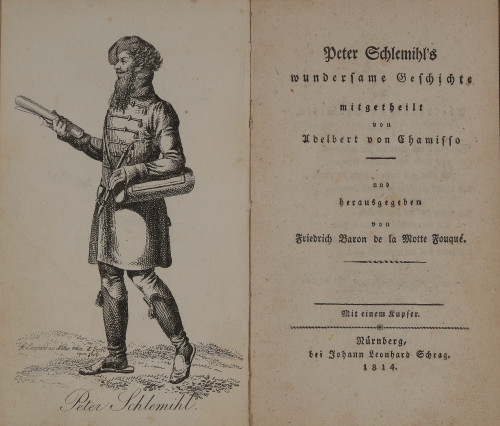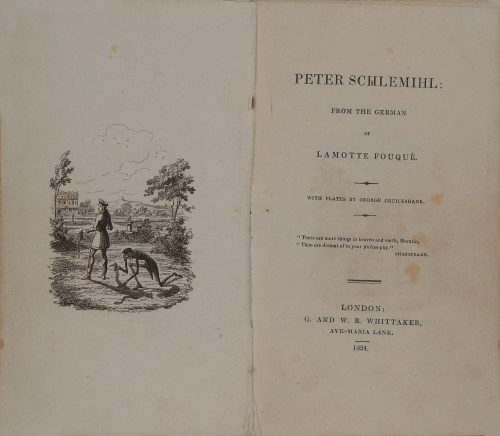Peter Schlemihl’s Wondrous Story, came out in 1814. In it, the author deliberately causes confusion by blending real people — for example his poet friend Fouqué and himself — with the fictional character Schlemihl. The interweave of life and art was typical of Romanticism. The illustration opposite the title page is a case in point: the bearded Peter Schlemihl in the travel coat resembles Chamisso. He holds travel documents and a pipe in his hands, and the specimen container is a reference to plant-collecting.
Adelbert von Chamisso came from an impoverished family of French aristocrats; his parents had settled in Berlin in 1796. After leaving the Prussian army, he devoted himself entirely to writing and research. In 1810 he travelled in France and Switzerland, and from 1815 to 1818 he participated in an expedition to the Norwegian Sea as a scientist.
The story of Peter Schlemihl is about a pact with the devil. A mysterious man dressed in grey offers Schlemihl a bottomless purse of gold in return for his shadow. Schlemihl accepts the offer, but the pleasure he takes in his wealth is short-lived because people shun the shadowless man. When he asks to reverse the imprudent deal, the “grey man” demands Schlemihl’s soul. This time, however, Schlemihl doesn’t allow himself to be led astray; he disposes of the magic purse and runs away. The opportunity to purchase seven-league boots presents itself to him, and he spends the last of his money on them. Now able to cover great distances with ease, he travels around the world as a naturalist — much like the author would later do in reality.
In his first-person narrative, Chamisso combined fairy-tale motifs with a seemingly realistic report of his experiences. The deal with the devil is depicted as a matter-of-fact business transaction. However, Schlemihl will soon have to face the fact that money doesn’t make you happy if it turns you into an outsider. The story can thus be understood as a warning against a purely economic approach to life. The author links his “romantic anti-economism” with an appeal for a form of trade that is beneficial to society as a whole. The end of the story has a conciliatory aspect, because, however lonely, as a scientist the hero can be of use to humankind. Peter Schlemihl’s Wondrous Story inspires us to reflect on our own values.
Objects
-

ADELBERT VON CHAMISSO
Peter Schlemihl’s wundersame Geschichte mitgetheilt von Adelbert von Chamisso und herausgegeben von Friedrich Baron de la Motte Fouqué
Nürnberg: Schrag 1814.
-

ADELBERT VON CHAMISSO
Peter Schlemihl: From the German of Lamotte Fouqué. With Plates by George Cruickshank
London: Whittaker 1824.
-

UNBEKANNTE/R KÜNSTLER/IN
Adelbert von Chamisso, ca. 1810
-
LUDWIG YORK CHORIS (1795‒1828)
Chamisso an Bord der Rurik in der Kajüte, 1815; Brigg Rurik mit Kriegsflagge und Kanonen, 1815